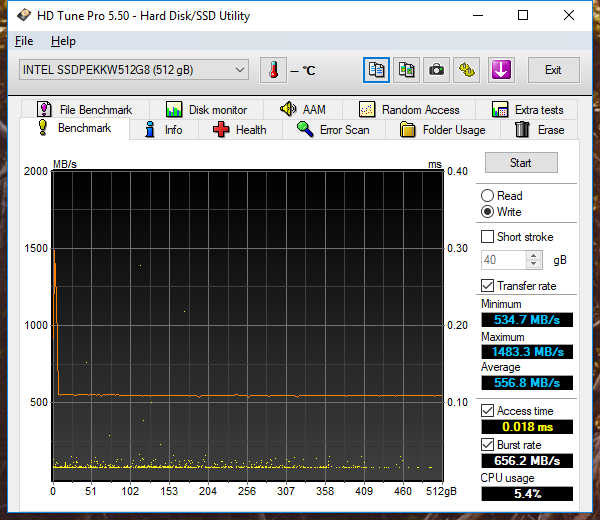HDTUNE
HD Tune is a Hard Disk Utility with many functions from error checking, health testing (S.M.A.R.T.), and of course benchmarking. To build upon our real world write test we also looked to see where the write speeds leveled off to by using HD Tune Pro. If SLC caching is being utilized, this test will typically show it.
Finally, taking a look at how it performs under HDTune’s full write test, we can see that after a few GB of data, the write performance drops down to about 550MB/s for the majority of the test.
REPORT ANALYSIS AND FINAL THOUGHTS
The all new Intel SSD 760P delivered a heck of a punch during our synthetic tests. Sequential figures that met or exceeded its 3230MB/s read and 1625MB/s write specifications. By testing with AS SSD, we were able to get 223K/257K IOPS read/write out of it, but only by utilizing Iometer were we able to extract the “rated for up to 340K IOPS” read performance and then some. Furthermore, the Intel 760P’s 4K QD1 read speed of over 75MB/s in CDM just can’t be ignored. That is the highest performance for that metric that we have seen yet!
Testing with PCMark 8, we saw that the Intel 760P delivered quite the performance boost over the Intel 600P, the previous test results weren’t only for show. Looking at this result as a whole, with an average bandwidth of 490MB/s during the standard test, the Intel 760P ranks ahead of most other TLC based NVMe SSDs and it is not much slower than many of the MLC based SSDs.
As it is with most TLC SSDs, the Intel 760P’s write performance suffers under our 30GB transfer test. While it is rated for up to 1.6GB/s write, it can only deliver such speed for only a few gigabytes, after that the SLC cache is exhausted and it writes as quickly as it can without the cache. In this test, it averaged just 671MB/s, this result, however, it is leaps and bounds faster than the 600P’s average of 285MB/s and faster than any SATA SSD’s potential. Furthermore, as a testament to its base write performance, we tested with HD Tune, which showed that the Intel 760P can slow to an average of 550MB/s after the cache is full. Finally, with an average transfer speed of 153MB/s per W and some of the lowest idle power consumption with ASPM enabled and disabled, the Intel 760P delivers improved efficiency over the Intel 750 series and 600P before it.
FINAL THOUGHTS
Intel’s latest 3D 64-layer NAND helps to not only double the 760P’s performance over the 600P, but also enables Intel to release the 760P at fairly low MSRPs in a time where the competition has to hike up their prices due to the NAND shortage. This, once again, just goes to show you what the power of owning the fab can do to give a company an advantage in the market.
The Intel SSD 760P has a lot going for it. Decent performance, especially for it being a TLC based product, lots of capacity options up to 2TB, though not all will be available at launch, and a great price point. To top things off it boasts a 5-year warranty and its endurance figures are better than that of the Samsung 960 EVO. What’s not to love? Sure, its small SLC cache runs out fairly quickly, but luckily for Intel, the majority of the consumer market doesn’t need such fast write performance 100% of the time, not even 20% of the time! If you are in need of a new M.2 NVMe SSD, the Intel 760P is a nice upgrade from any hard drive and will outpace any SATA SSD out.
 The SSD Review The Worlds Dedicated SSD Education and Review Resource |
The SSD Review The Worlds Dedicated SSD Education and Review Resource | 


How about the maximum power consumption of the Intel 760p during full throttle writing?
I want to buy an SSD that consumes not so much power and does not overheat, at a decent/medium speed (faster than a SATA though).
I’ve recorded about 5.25-5.5W during a large file copy to itself. Unless you are trasnfering multiple 60-100GB transfers within minutes from one NVMe SSD to another, you wont have overheating issues. Transfering from a SATA drive to an NVMe SSD isn’t going to cause much heat at all. With most drives, you can usually transfer from SATA to NVMe all day without heat issues.